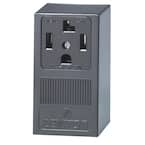Hey all, first time Tesla owner (Model 3) and first time poster here. I would really appreciate the community's help's on this. I recently bought a home that had a 50A 120/240 VAC/VCA breaker installed in the garage with a thick black cord sticking out of it that has a prong that states "30A 125/250V" on the side of it. Please see attached pictures to see what setup I currently have. I've also attached pictures of the prong.







From all my research, I think most people opt for the Tesla Wall Charger or getting a 14-50 outlet installed, but I would like to ask the community if there is any way I can charge my Tesla Model 3 with this current setup that was installed by the previous home owner. If I can avoid paying extra money for a Wall Charger and calling an electrician, that would be idea.
Thanks so much!
From all my research, I think most people opt for the Tesla Wall Charger or getting a 14-50 outlet installed, but I would like to ask the community if there is any way I can charge my Tesla Model 3 with this current setup that was installed by the previous home owner. If I can avoid paying extra money for a Wall Charger and calling an electrician, that would be idea.
Thanks so much!




